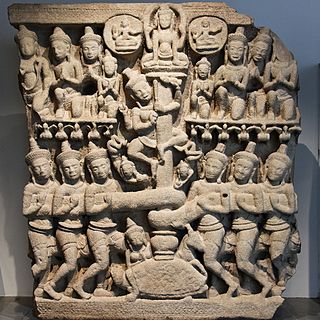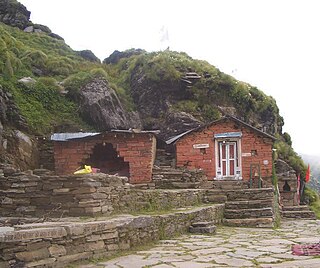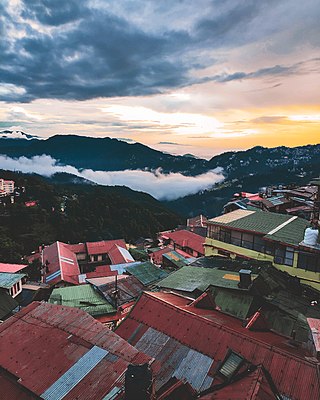Parashara was a maharishi and the author of many ancient Indian texts. He is accredited as the author of the first Purana, the Vishnu Purana, before his son Vyasa wrote it in its present form. He was the grandson of the sage Vasishtha and the son of the sage Shakti. There are several texts which give reference to Parashara as an author/speaker. The various texts attributed to him are given in reference to Parashara being the speaker to his student.
Barbarika (Barbarīka) Barbarika was the son of Ghatotkacha and Princess Maurvi, daughter of Daitya Moora, though other references state that he was a warrior from the south. He is not a character who appears in the original Mahabharata, likely retroactively added to certain traditions through syncretism. Barbarika was originally a yaksha, reborn as a man. He was bound by his principle of always fighting on the weaker side, which led him to stand witness to the Kurukshetra war without taking part in it.

Hindu mythological wars are the wars described in the Hindu texts of ancient India. These wars depicted both mortals of great prowess as well as deities and supernatural beings, often wielding supernatural weapons of great power. Hindu teachings prescribe war as the final option, to be employed only after all peaceful methods are exhausted. Participation in righteous war, or dharmayuddha, was said to be honourable and was a principal duty of the Kshatriya or the warrior varna, and victory in such wars was regarded as a matter of honour.
The following list consists of notable concepts that are derived from Hindu culture and associated cultures traditions, which are expressed as words in Sanskrit or other Indic languages and Dravidian languages. The main purpose of this list is to disambiguate multiple spellings, to make note of spellings no longer in use for these concepts, to define the concept in one or two lines, to make it easy for one to find and pin down specific concepts, and to provide a guide to unique concepts of Hinduism all in one place.

Haridwar district also spelled as Hardwar is a district in Garhwal which is a part of Uttarakhand, India. It is headquartered at Haridwar which is also its largest city. The district is ringed by the districts Dehradun in the north and east, Pauri Garhwal in the east and the Uttar Pradesh districts of Muzaffarnagar and Bijnor in the south and Saharanpur in the west.
Bakewar is a town and a nagar panchayat in Etawah district in the state of Uttar Pradesh, India. It is 22 km from district headquarters Etawah. Bakewar is famous for its very good education system, Agriculture Training Institute and for National highway no. 2. Bakewar is situated at national highway no. 2. It is between Agra and Kanpur, the two biggest cities of Uttar Pradesh. Agra is 145 km north and Kanpur is 135 km on south of Bakewar. Bharthana is the nearest railway (11 km) of Bakewar, situated in the east.

Rewalsar or Tso Pema in Tibetan is a small town and a pilgrimage place in a nagar panchayat in Mandi district in India. It is located in the state of Himachal Pradesh. The local name for Rewalsar is Tri Sangam. Rewalsar Lake is a tourist spot in the area.

Parashar Lake is a freshwater lake located at an elevation of 2,730 metres (8,960 ft) in the Mandi district of Himachal Pradesh, India. It lies 49 km (30 mi) east of the town of Mandi, and has a three storied pagoda-like temple dedicated to the sage Prashar situated on its bank. It contains a floating island.

Panch Kedar, rendered Pancha Kedara in Sanskrit, refers to five Hindu temples or holy places of the Shaivite sect dedicated to god Shiva. They are located in the Garhwal Himalayan region in Uttarakhand, India. They are the subject of many legends that directly link their creation to Pandavas, the heroes of the Indian epic Mahabharata.

Rudranath is a Hindu temple dedicated to God Shiva, located in the Garhwal Himalayan mountains in Uttarakhand, India. Located at 3,600 metres (11,800 ft) above sea level, this natural rock temple is situated within a dense forest of rhododendron dwarfs and Alpine pastures. The temple is the second temple to be visited in the Panch Kedar pilgrimage circuit, comprising five Shiva temples in the Garhwal region to be visited in a strict pecking order starting with Kedarnath at an altitude of 3,583 m, the Tungnath (तुंगनाथ)(3,680 m or 12,070 ft), Rudranath (रुद्रनाथ), Madhyamaheshwar (मध्यमहेश्वर) and Kalpeshwar (कल्पेश्वर).
Guptakashi, Gupta Kashi or Guptkashi is a fairly large town located at an elevation of 1,319 metres (4,327 ft) in the Kedar-khanda, in Garhwal Himalayas of Rudraprayag district in Uttarakhand, India. It is known for its ancient Vishwanath Temple dedicated to the god Shiva, which is similar to the one in Varanasi (Kashi). The other well known temple here is dedicated to Ardhanareshvara, a half man half woman form of Shiva and Parvati. The name Guptakashi has legendary significance linked to the Pandavas, the heroes of the Hindu epic Mahabharata. Its religious importance is considered next to that of Varanasi, believed to be the most pious of all Hindu pilgrimage sites.

The Bhima Devi Temple Complex, nicknamed Khajuraho of North India for its erotic sculptures, comprises the restored ruins of an ancient Hindu temple dating from between 8th and 11th century AD, together with the adjacent 17th-century Pinjore gardens, located in Pinjore town in Panchkula district of the state of Haryana, India. The old temple was destroyed by Islamic invaders and the present 8-11th CE temple is likely built on the same place under the old name, and the nearby ancient baoli still has old Hindu pillars. Bhimadevi belongs to the Shakti tradition that was derived from the Buddhist tantric goddess. Further, in the Devi Mahatmya it is said that in the Western Himalayas of Himachal Pradesh, Bhimadevi appeared in an enormous form of Bhimarupa and gave protection to the sages. The site was worked upon extensively by the team of Speaking Archaeologically from 2017 to 2019, with preliminary survey beginning as early as in 2015 and the report was published as the Speaking Archaeologically Journal Volume III:Bhima Devi Project Edition in 2020.
Mukteshwar Mahadev Temple, also known as Mukesaran Mandir, is a shrine to Shiva and man-made cave complex located near Pathankot City, Punjab, India. on Shahpur Kandi Dam road. It is a Hindu temple containing representations of Ganesha, Brahma, Vishnu, Hanuman, and Parvati. It is considered to be one of the most sacred places around Pathankot. According to legend, the Pandavas stayed in the caves for a night during their exile (Agayatwas), and it is said that some of the caves date to the time of the Mahabharata.
In the Hindu epic the Mahabharata, Ashwatthama or Drauni is the son of guru Drona and Kripi. and a pivotal character in the Mahabharata. The grandson of the sage Bharadwaja, Ashwatthama ruled the northern region of Panchala with Ahichhatra as his capital, being subordinate to the rulers of Hastinapura. He was a Maharathi who fought on the Kaurava side against the Pandavas in the Kurukshetra War. He became a Chiranjivi (immortal) on being blessed by Shiva.

Karsog is a town and municipal area in the state of Himachal Pradesh in northern India.

Doleshwor Mahadeva is a Hindu Temple of Lord Shiva located in Suryabinayak, south eastern part of Bhaktapur District, Nepal, and is believed to be the head part of Kedarnath temple located in Uttarakhand, India.

Tourism in Himachal Pradesh relates to tourism in the Indian state of Himachal Pradesh. This is popularly renowned for its Himalayan landscapes and popular hill-stations. Many outdoor activities such as rock climbing, mountain biking, paragliding, ice-skating, trekking, rafting, and heli-skiing are popular tourist attractions in Himachal Pradesh.

Nirmand is a village located in Kullu district, of the Indian state of Himachal Pradesh. It is one of the largest villages in Himachal Pradesh and serves as the headquarters of Nirmand Tehsil and Nirmand developmental block of Kullu district.

The Pancha Kshetrams or Pancha Bhargavi Kshethram is a group of five sacred Hindu temples in India, dedicated the deity Vishnu and Lakshmi With the legend associated to the Venkateswara Temple, Tirumala. All the temples are Divya desams except one which is an Abhimana Kshethram.















